Assessing Seasonal and Inter-Annual Changes in the Total Cover of Submerged Aquatic Vegetation Using Sentinel-2 Imagery
Abstract
:1. Introduction
2. Materials and Methods
2.1. Study Area
2.2. Satellite Imagery
2.3. Optically Deep Water (ODW) Mask
2.4. Physics-Based IDA Model
2.5. Area Estimates
3. Results
3.1. Intra-Annual Variations in SAV %Cover
3.2. Inter-Annual Variations in SAV Cover
4. Discussion
5. Conclusions
Author Contributions
Funding
Data Availability Statement
Conflicts of Interest
Appendix A

References
- Macreadie, P.I.; Jarvis, J.; Trevathan-Tackett, S.M.; Bellgrove, A. Seagrasses and Macroalgae: Importance, Vulnerability and Impacts. In Climate Change Impacts on Fisheries and Aquaculture; John Wiley & Sons, Ltd.: Hoboken, NJ, USA, 2017; pp. 729–770. [Google Scholar]
- Cotas, J.; Gomes, L.; Pacheco, D.; Pereira, L. Ecosystem Services Provided by Seaweeds. Hydrobiology 2023, 2, 75–96. [Google Scholar] [CrossRef]
- Duarte, C.M. Submerged Aquatic Vegetation in Relation to Different Nutrient Regimes. Ophelia 1995, 41, 87–112. [Google Scholar] [CrossRef]
- Meier, H.E.M.; Andersson, H.C.; Arheimer, B.; Blenckner, T.; Chubarenko, B.; Donnelly, C.; Eilola, K.; Gustafsson, B.G.; Hansson, A.; Havenhand, J.; et al. Comparing Reconstructed Past Variations and Future Projections of the Baltic Sea Ecosystem—First Results from Multi-Model Ensemble Simulations. Environ. Res. Lett. 2012, 7, 034005. [Google Scholar] [CrossRef]
- Andersson, A.; Meier, H.E.M.; Ripszam, M.; Rowe, O.; Wikner, J.; Haglund, P.; Eilola, K.; Legrand, C.; Figueroa, D.; Paczkowska, J.; et al. Projected Future Climate Change and Baltic Sea Ecosystem Management. Ambio 2015, 44, 345–356. [Google Scholar] [CrossRef] [PubMed]
- Wikström, S.A.; Carstensen, J.; Blomqvist, M.; Krause-Jensen, D. Cover of Coastal Vegetation as an Indicator of Eutrophication along Environmental Gradients. Mar. Biol. 2016, 163, 257. [Google Scholar] [CrossRef] [PubMed]
- Herkül, K.; Kotta, J.; Pärnoja, M. Effect of Physical Disturbance on the Soft Sediment Benthic Macrophyte and Invertebrate Community in the Northern Baltic Sea. Boreal Environ. Res. 2011, 16, 209–219. [Google Scholar]
- Zhang, Q.; Xu, Y.S.; Huang, L.; Xue, W.; Sun, G.Q.; Zhang, M.X.; Yu, F.H. Does Mechanical Disturbance Affect the Performance and Species Composition of Submerged Macrophyte Communities? Sci. Rep. 2014, 4, 4888. [Google Scholar] [CrossRef] [PubMed]
- Kutser, T.; Hedley, J.; Giardino, C.; Roelfsema, C.; Brando, V.E. Remote Sensing of Shallow Waters—A 50 Year Retrospective and Future Directions. Remote Sens. Environ. 2020, 240, 111619. [Google Scholar] [CrossRef]
- Benfield, S.L.; Guzman, H.M.; Mair, J.M.; Young, J.A.T. Mapping the Distribution of Coral Reefs and Associated Sublittoral Habitats in Pacific Panama: A Comparison of Optical Satellite Sensors and Classification Methodologies. Int. J. Remote Sens. 2007, 28, 5047–5070. [Google Scholar] [CrossRef]
- Casal, G.; Kutser, T.; Domínguez-Gómez, J.A.; Sánchez-Carnero, N.; Freire, J. Mapping Benthic Macroalgal Communities in the Coastal Zone Using CHRIS-PROBA Mode 2 Images. Estuar. Coast. Shelf Sci. 2011, 94, 281–290. [Google Scholar] [CrossRef]
- Hill, V.J.; Zimmerman, R.C.; Bissett, W.P.; Dierssen, H.; Kohler, D.D.R. Evaluating Light Availability, Seagrass Biomass, and Productivity Using Hyperspectral Airborne Remote Sensing in Saint Joseph’s Bay, Florida. Estuaries Coasts 2014, 37, 1467–1489. [Google Scholar] [CrossRef]
- Eugenio, F.; Marcello, J.; Martin, J. High-Resolution Maps of Bathymetry and Benthic Habitats in Shallow-Water Environments Using Multispectral Remote Sensing Imagery. IEEE Trans. Geosci. Remote Sens. 2015, 53, 3539–3549. [Google Scholar] [CrossRef]
- Traganos, D.; Reinartz, P. Mapping Mediterranean Seagrasses with Sentinel-2 Imagery. Mar. Pollut. Bull. 2018, 134, 197–209. [Google Scholar] [CrossRef]
- Kuhwald, K.; Schneider von Deimling, J.; Schubert, P.; Oppelt, N. How Can Sentinel-2 Contribute to Seagrass Mapping in Shallow, Turbid Baltic Sea Waters? Remote Sens. Ecol. Conserv. 2021, 8, 328–346. [Google Scholar] [CrossRef]
- Ghirardi, N.; Bolpagni, R.; Bresciani, M.; Valerio, G.; Pilotti, M.; Giardino, C. Spatiotemporal Dynamics of Submerged Aquatic Vegetation in a Deep Lake from Sentinel-2 Data. Water 2019, 11, 563. [Google Scholar] [CrossRef]
- Fritz, C.; Kuhwald, K.; Schneider, T.; Geist, J.; Oppelt, N. Sentinel-2 for Mapping the Spatio-Temporal Development of Submerged Aquatic Vegetation at Lake Starnberg (Germany). J. Limnol. 2019, 78, 71–91. [Google Scholar] [CrossRef]
- Ivajnšič, D.; Orlando-Bonaca, M.; Donša, D.; Grujić, V.J.; Trkov, D.; Mavrič, B.; Lipej, L. Evaluating Seagrass Meadow Dynamics by Integrating Field-Based and Remote Sensing Techniques. Plants 2022, 11, 1196. [Google Scholar] [CrossRef] [PubMed]
- Vahtmäe, E.; Toming, K.; Argus, L.; Möller-Raid, T.; Ligi, M.; Kutser, T. On the Possibility to Map Submerged Aquatic Vegetation Cover with Sentinel-2 in Low-Transparency Waters. J. Appl. Remote Sens. 2023, 17, 044506. [Google Scholar] [CrossRef]
- Dekker, A.G.; Phinn, S.R.; Anstee, J.; Bissett, P.; Brando, V.E.; Casey, B.; Fearns, P.; Hedley, J.; Klonowski, W.; Lee, Z.P.; et al. Intercomparison of Shallow Water Bathymetry, Hydro-Optics, and Benthos Mapping Techniques in Australian and Caribbean Coastal Environments. Limnol. Oceanogr. Methods 2011, 9, 396–425. [Google Scholar] [CrossRef]
- Suursaar, Ü.; Kullas, T.; Otsmann, M. Flow Modelling in the Pärnu Bay and the Kihnu Strait. Proc. Est. Acad. Sci. Eng. 2002, 8, 189–203. [Google Scholar]
- Kotta, J.; Lauringson, V.; Martin, G.; Simm, M.; Kotta, I.; Herkül, K.; Ojaveer, H. Gulf of Riga and Pärnu Bay. In Ecology of Baltic Coastal Waters; Schiewer, U., Ed.; Springer: Berlin/Heidelberg, Germany, 2008; pp. 217–243. [Google Scholar]
- Hedley, J.D.; Roelfsema, C.; Brando, V.; Giardino, C.; Kutser, T.; Phinn, S.; Mumby, P.J.; Barrilero, O.; Laporte, J.; Koetz, B. Coral Reef Applications of Sentinel-2: Coverage, Characteristics, Bathymetry and Benthic Mapping with Comparison to Landsat 8. Remote Sens. Environ. 2018, 216, 598–614. [Google Scholar] [CrossRef]
- Casal, G.; Hedley, J.D.; Monteys, X.; Harris, P.; Cahalane, C.; McCarthy, T. Satellite-Derived Bathymetry in Optically Complex Waters Using a Model Inversion Approach and Sentinel-2 Data. Estuar. Coast. Shelf Sci. 2020, 241, 10681. [Google Scholar] [CrossRef]
- Goodman, J.A.; Lee, Z.P.; Ustin, S.L. Influence of Atmospheric and Sea-Surface Corrections on Retrieval of Bottom Depth and Reflectance Using a Semi-Analytical Model: A Case Study in Kaneohe Bay, Hawaii. Appl. Opt. 2008, 47, F1–F11. [Google Scholar] [CrossRef]
- Vahtmäe, E.; Kotta, J.; Lõugas, L.; Kutser, T. Mapping Spatial Distribution, Percent Cover and Biomass of Benthic Vegetation in Optically Complex Coastal Waters Using Hyperspectral CASI and Multispectral Sentinel-2 Sensors. Int. J. Appl. Earth Obs. Geoinf. 2021, 102, 102444. [Google Scholar] [CrossRef]
- Hedley, J.; Roelfsema, C.; Phinn, S.R. Efficient Radiative Transfer Model Inversion for Remote Sensing Applications. Remote Sens. Environ. 2009, 113, 2527–2532. [Google Scholar] [CrossRef]
- Garcia, R.A.; Lee, Z.; Hochberg, E.J. Hyperspectral Shallow-Water Remote Sensing with an Enhanced Benthic Classifier. Remote Sens. 2018, 10, 147. [Google Scholar] [CrossRef]
- Herkül, K.; Torn, K.; Möller-Raid, T.; Martin, G. Distribution and Co-Occurrence Patterns of Charophytes and Angiosperms in the Northern Baltic Sea. Sci. Rep. 2023, 13, 147. [Google Scholar] [CrossRef]
- Kovtun, A.; Torn, K.; Kotta, J. Long-Term Changes in a Northern Baltic Macrophyte Community. Est. J. Ecol. 2009, 58, 270–285. [Google Scholar] [CrossRef]
- Kraufvelin, P.; Salovius, S. Animal Diversity in Baltic Rocky Shore Macroalgae: Can Cladophora Glomerata Compensate for Lost Fucus Vesiculosus? Estuar. Coast. Shelf Sci. 2004, 61, 369–378. [Google Scholar] [CrossRef]
- Kotta, J.; Torn, K.; Paalme, T.; Rätsep, M.; Kaljurand, K.; Teeveer, M.; Kotta, I. Scale-Specific Patterns of the Production of the Charophyte Chara Aspera in the Brackish Baltic Sea: Linking Individual and Community Production and Biomass Growth. Front. Mar. Sci. 2021, 8, 674014. [Google Scholar] [CrossRef]
- Jankowska, E.; Włodarska-Kowalczuk, M.; Kotwicki, L.; Balazy, P.; Kuliński, K. Seasonality in Vegetation Biometrics and Its Effects on Sediment Characteristics and Meiofauna in Baltic Seagrass Meadows. Estuar. Coast. Shelf Sci. 2014, 139, 159–170. [Google Scholar] [CrossRef]
- Jerker, I.-A. Dynamics of Submerged Aquatic Vegetation on Shallow Soft Bottoms in the Baltic Sea. J. Veg. Sci. 2000, 11, 425–432. [Google Scholar] [CrossRef]
- Paar, M.; Berthold, M.; Schumann, R.; Dahlke, S.; Blindow, I. Seasonal Variation in Biomass and Production of the Macrophytobenthos in Two Lagoons in the Southern Baltic Sea. Front. Earth Sci. 2021, 8, 542391. [Google Scholar] [CrossRef]
- Wang, K.; Leppäranta, M.; Kõuts, T. A Study of Sea Ice Dynamic Events in a Small Bay. Cold Reg. Sci. Technol. 2006, 45, 83–94. [Google Scholar] [CrossRef]
- Meteorological Yearbooks of Estonia. Available online: https://www.ilmateenistus.ee/ilmatarkus/publikatsioonid/aastaraamatud/ (accessed on 20 December 2023).
- Finnish Environmental Institute. (SYKE) TARKKA Portal. Available online: https://wwwi4.ymparisto.fi/i4/fin/tarkka (accessed on 20 December 2023).
- Herkül, K.; Kotta, J.; Kotta, I.; Orav-Kotta, H.; Herkül, K.; Kotta, J.; Kotta, I.; Orav-Kotta, H. Effects of Physical Disturbance, Isolation and Key Macrozoobenthic Species on Community Development, Recolonisation and Sedimentation Processes. Oceanologia 2006, 48, 267–282. [Google Scholar]

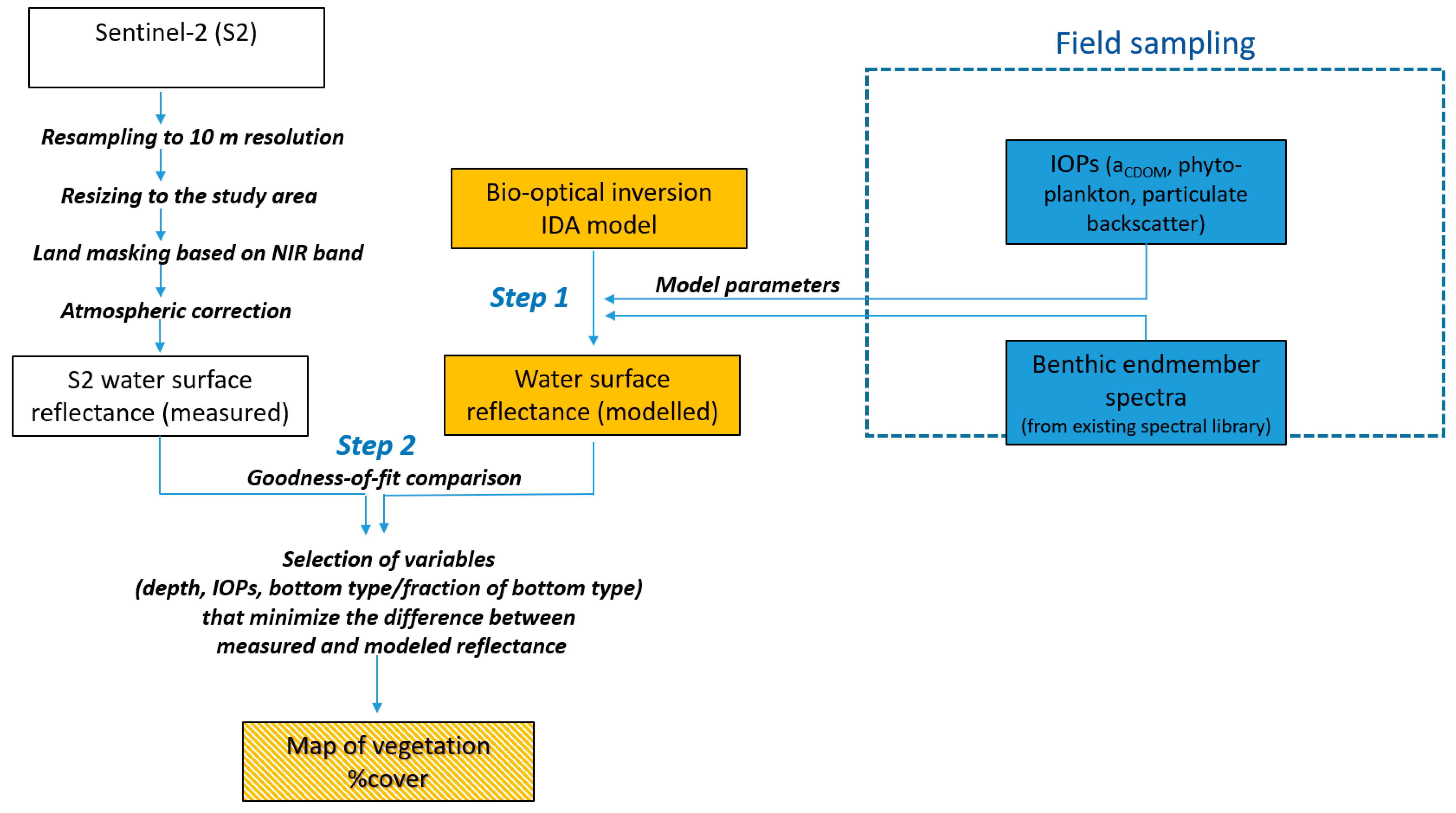
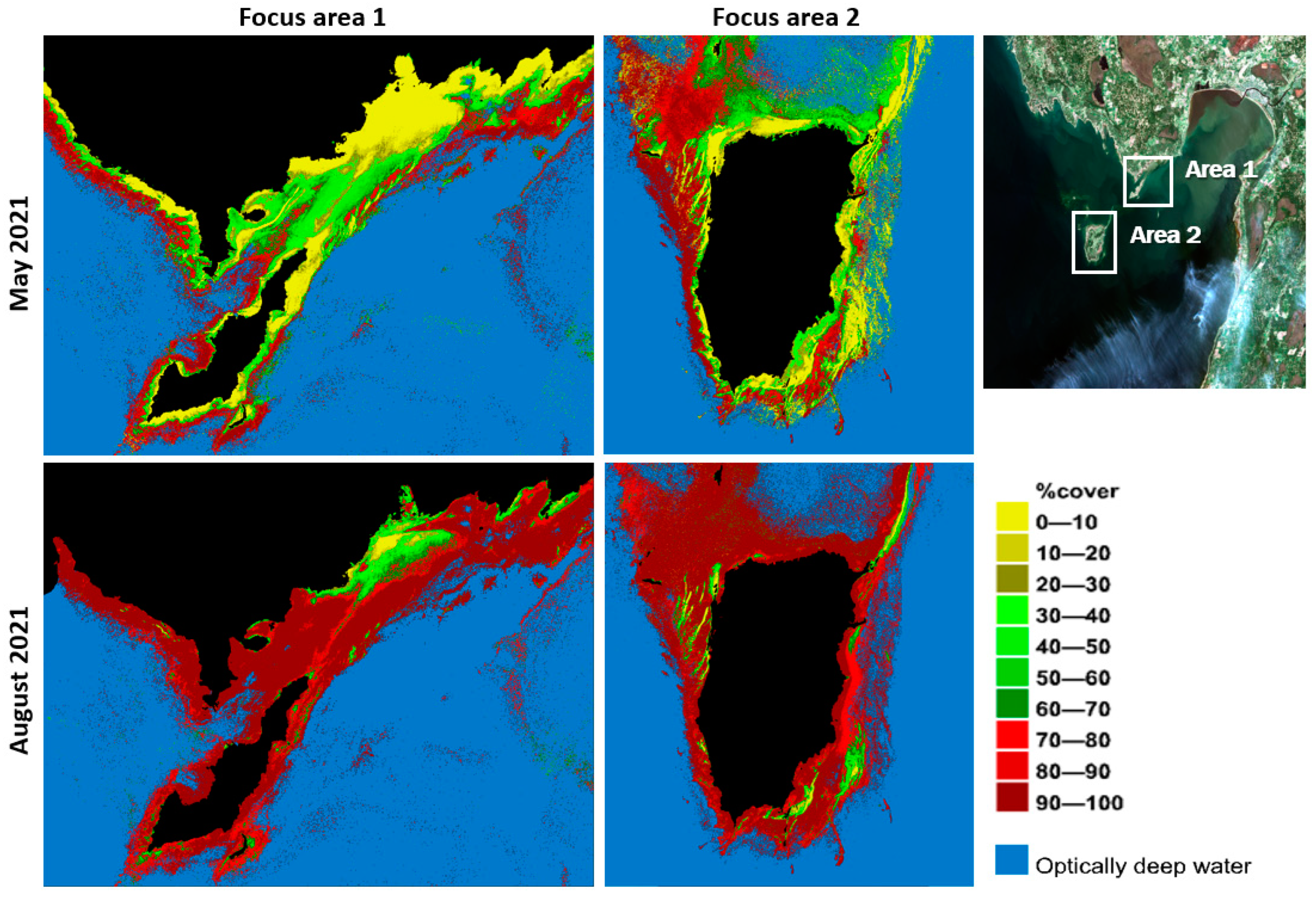
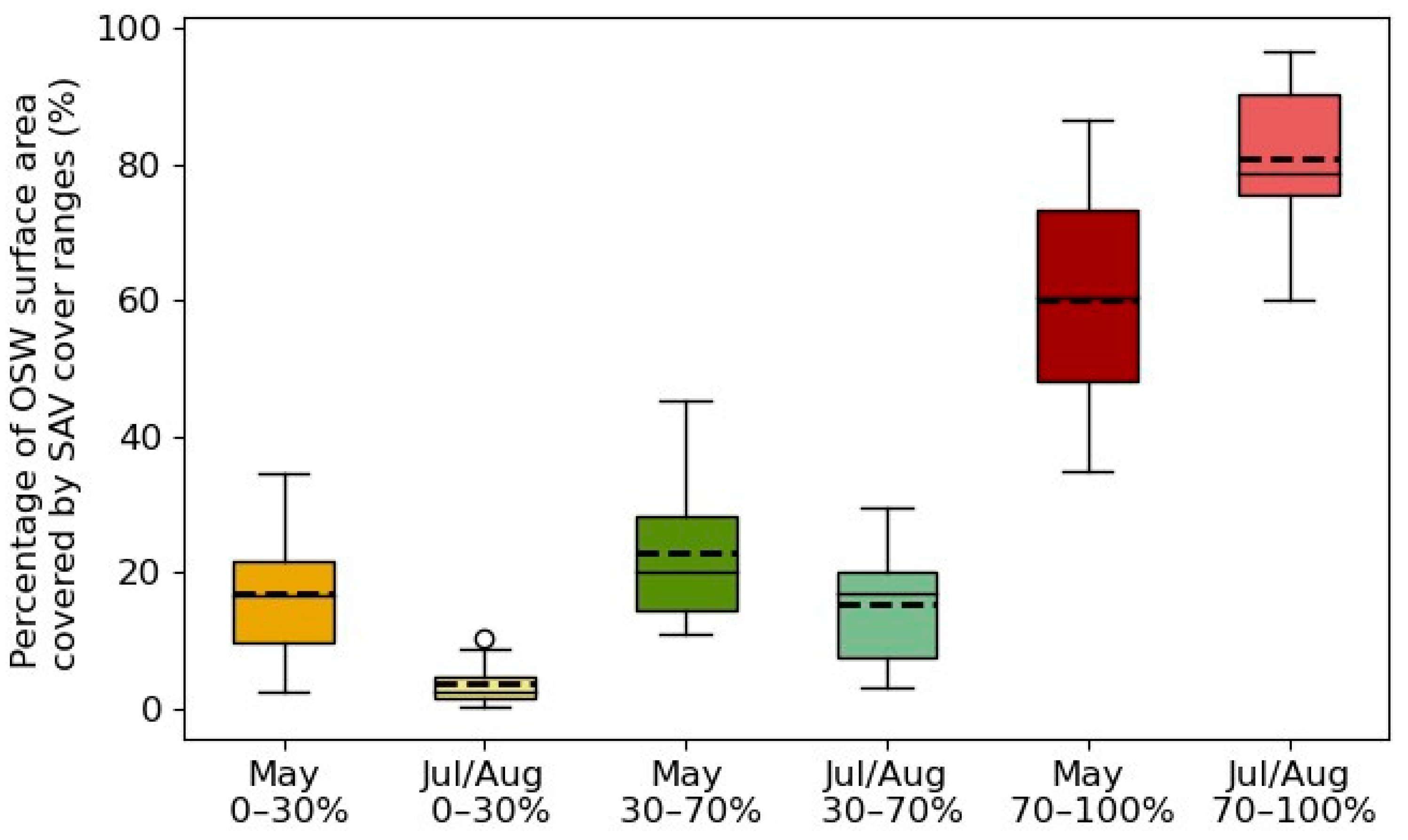
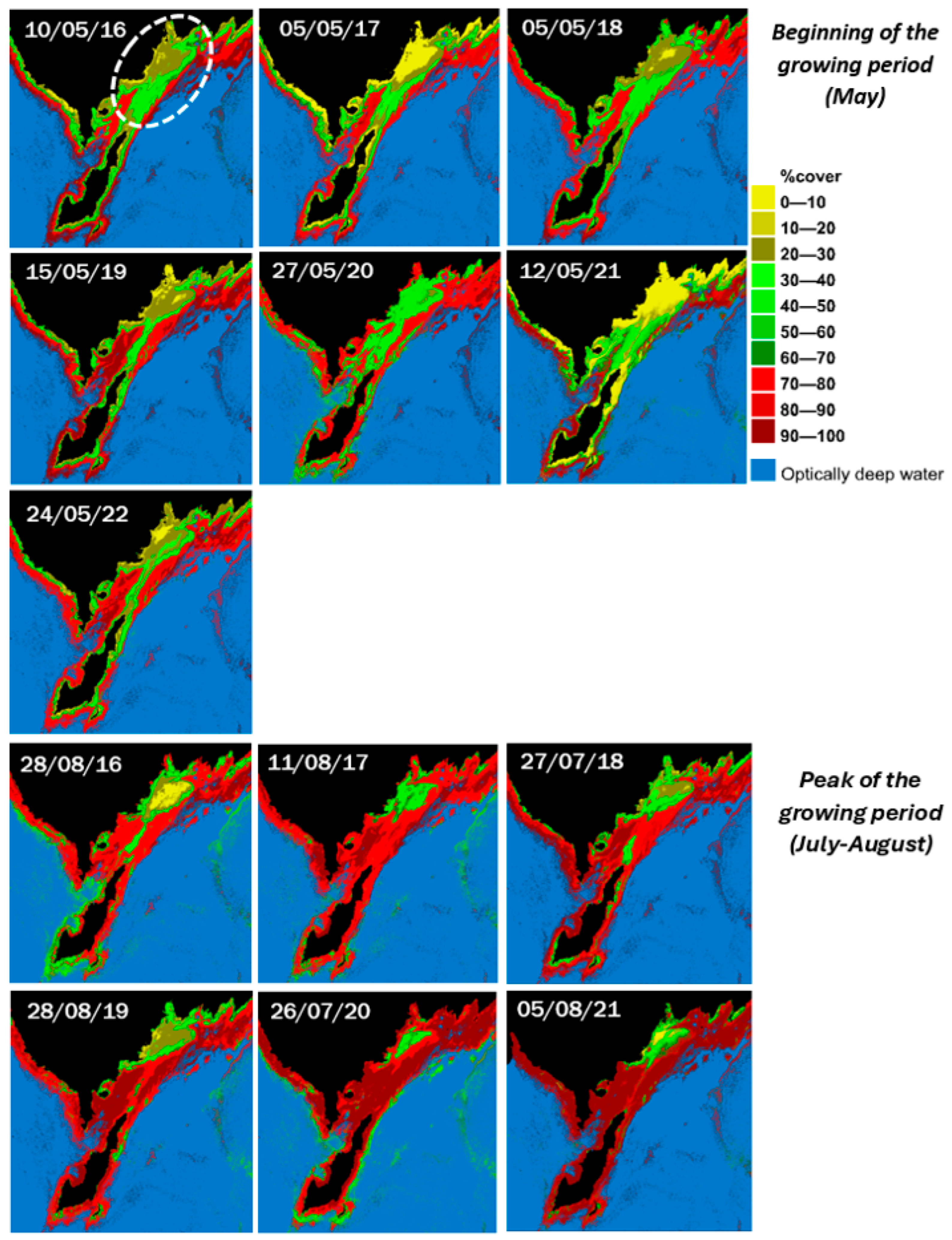

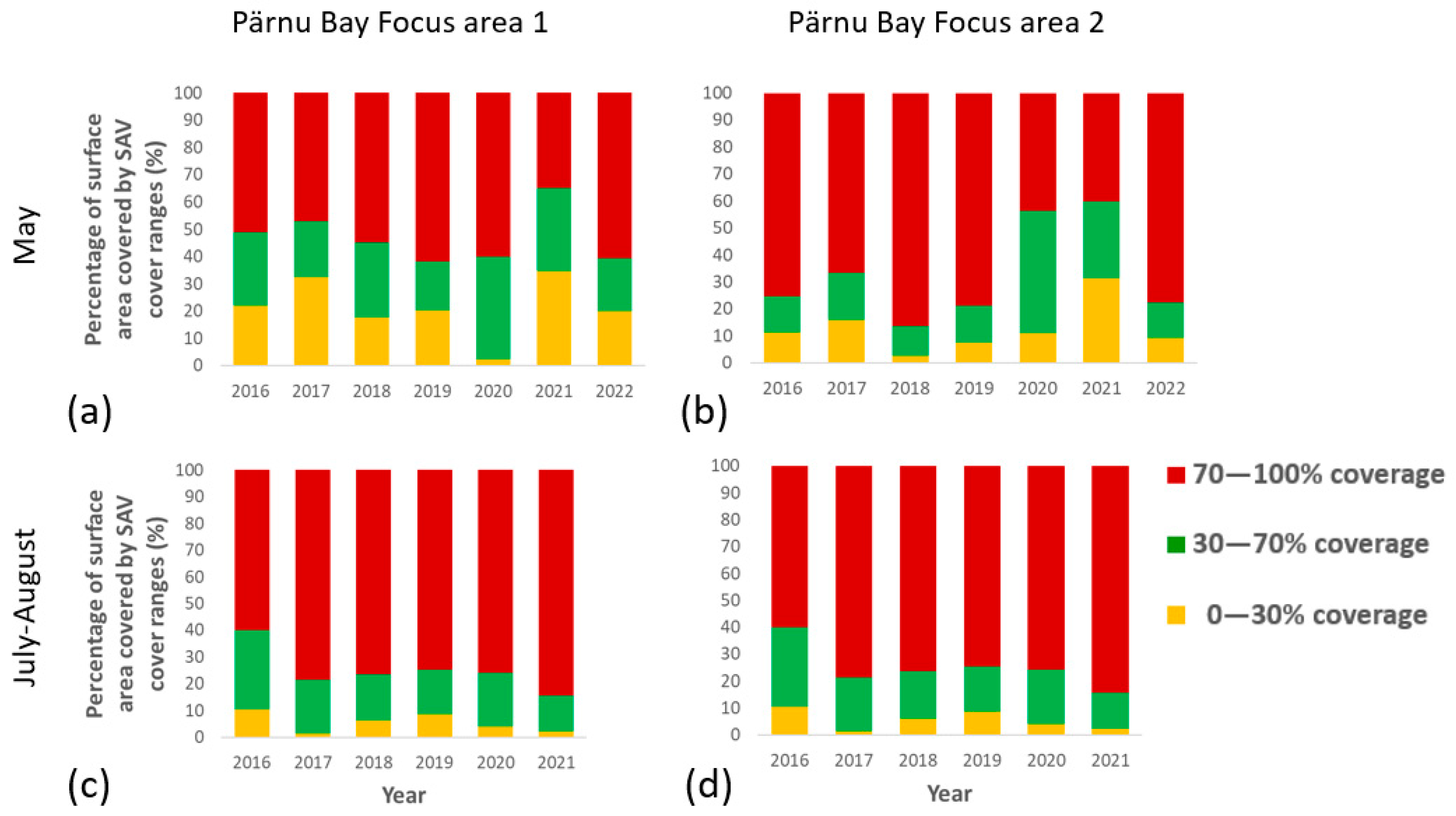
| Beginning of the Growing Period | Peak of the Growing Period |
|---|---|
| 5 May 2016 | 28 August 2016 |
| 5 May 2017 | 11 August 2017 |
| 5 May 2018 | 27 July 2018 |
| 15 May 2019 | 28 August 2019 |
| 27 May 2020 | 26 July 2020 |
| 12 May 2021 | 5 August 2021 |
| 24 May 2022 | - |
| Focus Area 1 | Focus Area 2 | |
|---|---|---|
| Total surface area | 83 km2 | 95 km2 |
| Land mask | * 22 km2 | * 18 km2 |
| ODW mask | 42 km2 | 49 km2 |
| OSW area | 19 km2 | 28 km2 |
Disclaimer/Publisher’s Note: The statements, opinions and data contained in all publications are solely those of the individual author(s) and contributor(s) and not of MDPI and/or the editor(s). MDPI and/or the editor(s) disclaim responsibility for any injury to people or property resulting from any ideas, methods, instructions or products referred to in the content. |
© 2024 by the authors. Licensee MDPI, Basel, Switzerland. This article is an open access article distributed under the terms and conditions of the Creative Commons Attribution (CC BY) license (https://creativecommons.org/licenses/by/4.0/).
Share and Cite
Vahtmäe, E.; Argus, L.; Toming, K.; Möller-Raid, T.; Kutser, T. Assessing Seasonal and Inter-Annual Changes in the Total Cover of Submerged Aquatic Vegetation Using Sentinel-2 Imagery. Remote Sens. 2024, 16, 1396. https://doi.org/10.3390/rs16081396
Vahtmäe E, Argus L, Toming K, Möller-Raid T, Kutser T. Assessing Seasonal and Inter-Annual Changes in the Total Cover of Submerged Aquatic Vegetation Using Sentinel-2 Imagery. Remote Sensing. 2024; 16(8):1396. https://doi.org/10.3390/rs16081396
Chicago/Turabian StyleVahtmäe, Ele, Laura Argus, Kaire Toming, Tiia Möller-Raid, and Tiit Kutser. 2024. "Assessing Seasonal and Inter-Annual Changes in the Total Cover of Submerged Aquatic Vegetation Using Sentinel-2 Imagery" Remote Sensing 16, no. 8: 1396. https://doi.org/10.3390/rs16081396
APA StyleVahtmäe, E., Argus, L., Toming, K., Möller-Raid, T., & Kutser, T. (2024). Assessing Seasonal and Inter-Annual Changes in the Total Cover of Submerged Aquatic Vegetation Using Sentinel-2 Imagery. Remote Sensing, 16(8), 1396. https://doi.org/10.3390/rs16081396






